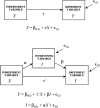A comparison of methods to test mediation and other intervening variable effects
- PMID: 11928892
- PMCID: PMC2819363
- DOI: 10.1037/1082-989x.7.1.83
A comparison of methods to test mediation and other intervening variable effects
Abstract
A Monte Carlo study compared 14 methods to test the statistical significance of the intervening variable effect. An intervening variable (mediator) transmits the effect of an independent variable to a dependent variable. The commonly used R. M. Baron and D. A. Kenny (1986) approach has low statistical power. Two methods based on the distribution of the product and 2 difference-in-coefficients methods have the most accurate Type I error rates and greatest statistical power except in 1 important case in which Type I error rates are too high. The best balance of Type I error and statistical power across all cases is the test of the joint significance of the two effects comprising the intervening variable effect.
Figures
References
-
- Ajzen I, Fishbein M. Understanding attitudes and predicting social behavior. Prentice Hall; Englewood Cliffs, NJ: 1980.
-
- Allison PD. The impact of random predictors on comparison of coefficients between models: Comment on Clogg, Petkova, and Haritou. American Journal of Sociology. 1995;100:1294–1305.
-
- Alwin DF, Hauser RM. The decomposition of effects in path analysis. American Sociological Review. 1975;40:37–47.
-
- Aroian LA. The probability function of the product of two normally distributed variables. Annals of Mathematical Statistics. 1944;18:265–271.
-
- Baron RM, Kenny DA. The moderator–mediator variable distinction in social psychological research: Conceptual, strategic, and statistical considerations. Journal of Personality and Social Psychology. 1986;51:1173–1182. - PubMed
Publication types
MeSH terms
Grants and funding
LinkOut - more resources
Full Text Sources
Medical


